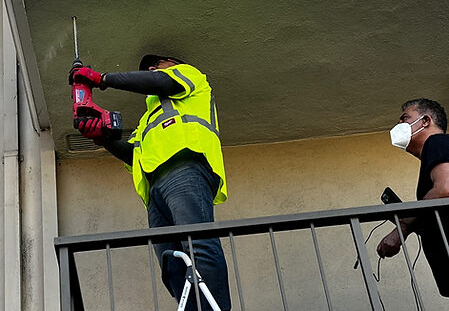SB721 Inspection Reporting Requirements

Table of Contents
In California, SB721 Inspections are critical for ensuring the safety and structural integrity of exterior elevated elements (EEEs) such as balconies, decks, and stairways. For property owners and managers, understanding the reporting requirements can often feel overwhelming. This guide breaks down the reporting process, offering a simplified, step-by-step explanation to help you comply with SB721 and submit thorough and compliant inspection reports.
SB721 Inspections were mandated by California’s Senate Bill 721, introduced to address structural failures in exterior elevated elements of multifamily residential buildings. These inspections focus on assessing the safety of load-bearing components exposed to the elements and are required for buildings with three or more dwelling units.
Key features of SB721 inspections include:
- Frequency: Inspections must be conducted once every six years.
- Scope: Evaluations include balconies, decks, walkways, and stairways supported by wood or other load-bearing materials.
- Compliance: Reports must meet specific criteria and be submitted to the appropriate authorities.
What Must an SB721 Inspection Report Include?
A compliant SB721 inspection report must provide a comprehensive analysis of the inspected property. Below are the key components of a report:
1. Detailed Description of Inspected Elements
- A list of all inspected EEEs, including balconies, decks, and stairways.
- Documentation of the material type, age, and any known maintenance history.
- Photographic evidence of the inspected elements to support findings.
2. Assessment of Structural Integrity
- Evaluation of wood, metal, or other load-bearing materials for:
- Cracks
- Rot
- Rust
- Corrosion
- Identification of hidden damage caused by moisture or environmental factors.
3. Identified Deficiencies
- Detailed descriptions of any hazardous conditions found during the inspection.
- Priority levels for deficiencies based on severity:
- Immediate safety risks
- Long-term structural concerns
4. Recommendations for Repairs or Replacements
- Suggestions for addressing deficiencies, including:
- Repair methodologies
- Replacement materials
- Timelines for completion
5. Inspector Certification
- The report must be prepared and signed by a licensed professional engineer or architect, as required by SB721.
Contact DrBalcony for a professional inspection!
Ensure the safety of your balcony and living space with DrBalcony - We're a Tech Engineering firm that specializes in California SB326 & SB721 balcony inspections. Over 3000+ completed projects in California.
Request A Free EstimateClick To CallStep-by-Step Guide to Submitting an SB721 Inspection Report
To ensure compliance with SB721, property owners must follow these steps when submitting inspection reports:
Step 1: Conduct a Thorough Inspection
- Hire a licensed professional engineer or certified inspector with experience in balcony and deck evaluations.
- Confirm that the inspection covers all EEEs as outlined in SB721.
Step 2: Prepare a Comprehensive Report
- Include all required elements: descriptions, assessments, deficiencies, and recommendations.
- Use clear and concise language supported by visual evidence such as photographs.
Step 3: Submit the Report
- Submit the completed report to the local building department within 60 days of the inspection.
- If immediate safety hazards are identified, notify the appropriate authorities within 15 days.
Step 4: Address Required Repairs
- Implement recommended repairs promptly to prevent further deterioration.
- Retain records of completed repairs for future inspections.
Common Reporting Mistakes to Avoid
Even experienced property managers can make errors in SB721 reporting. Here are some common pitfalls and how to avoid them:
| Mistake | Impact | Solution |
|---|---|---|
| Failing to include all EEEs | Leads to incomplete inspections and non-compliance | Use a checklist to ensure all elements are covered. |
| Missing deadlines | Results in penalties and legal complications | Set reminders to submit reports on time. |
| Inadequate documentation | Causes delays in repair approvals | Include photos and detailed descriptions. |
| Hiring unqualified inspectors | May result in inaccurate or rejected reports | Verify inspector licenses and experience. |
How Do SB721 Inspections Benefit Property Owners?
While compliance may seem burdensome, SB721 inspections provide significant advantages for property owners:
- Improved Safety: Identifies risks before they lead to accidents or structural failures.
- Cost Savings: Early detection of issues reduces expensive emergency repairs.
- Increased Property Value: Regular inspections and well-maintained structures boost property resale values.
- Legal Compliance: Avoids penalties and liability risks associated with non-compliance.
Case Study: How Proactive Inspections Saved a California Property Owner Thousands
A multifamily property owner in Los Angeles hired DrBalcony to perform an SB721 inspection. During the evaluation, hidden moisture damage was discovered in a balcony’s load-bearing beams. By acting quickly to repair the damage, the owner avoided a potential collapse and saved over $25,000 in emergency repair costs. The timely inspection also ensured compliance with local regulations, protecting the owner from fines.
Why Choose DrBalcony for SB721 Inspections
At DrBalcony, we specialize in helping property owners and HOAs navigate the complexities of SB721 inspections. Here’s why we’re the right partner for your inspection needs:
- Licensed Experts: Our team includes licensed engineers and inspectors with decades of experience.
- Advanced Technology: We use cutting-edge tools to detect hidden damage and ensure accurate evaluations.
- Comprehensive Reports: We provide clear, detailed, and compliant reports to streamline the submission process.
- Timely Service: With the SB721 deadline approaching, we ensure your inspections are completed on time.
Contact DrBalcony for a professional inspection!
Ensure the safety of your balcony and living space with DrBalcony - We're a Tech Engineering firm that specializes in California SB326 & SB721 balcony inspections. Over 3000+ completed projects in California.
Request A Free EstimateClick To CallEnsure your property remains safe, compliant, and investment-ready. Contact DrBalcony today to schedule your SB721 inspection and receive a detailed, compliant report from industry-leading experts.
FAQ Section: Top Questions & Answers
My property is well-maintained. Do I really need SB-326/SB-721 inspections?
YES! Even with excellent maintenance, hidden issues can develop due to construction errors, material flaws, or severe weather exposure. Inspections are about ensuring those don’t turn into major problems.
Our balconies were inspected a few years ago – isn't that enough?
Unfortunately, no. California laws mandate inspections on a set schedule, often every 6 years. Deterioration can happen quickly, making regular assessments essential.
Can I use my regular handyman for the balcony inspection?
It’s not recommended. Unless they hold specific licenses (architect, structural engineer, etc.) their inspection won’t be considered valid for SB-326/SB-721 compliance.
What if the inspection uncovers major issues?
First, don’t panic! Early detection often means less extensive (and expensive) repairs are needed. Work with your inspector to prioritize fixes, and explore if they offer repair services for a streamlined solution.
I'm worried about the cost of inspections. Are there any resources to help?
Start by getting detailed quotes from multiple companies. Factor in that proactive inspections help you avoid even bigger costs down the line due to neglected problems. Some property management associations offer guidance on budgeting for balcony compliance.

